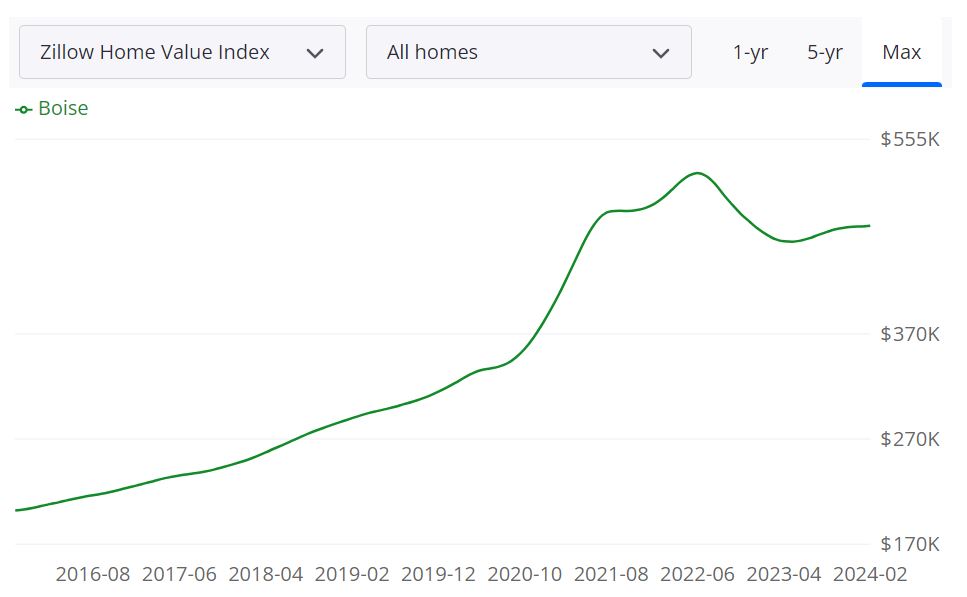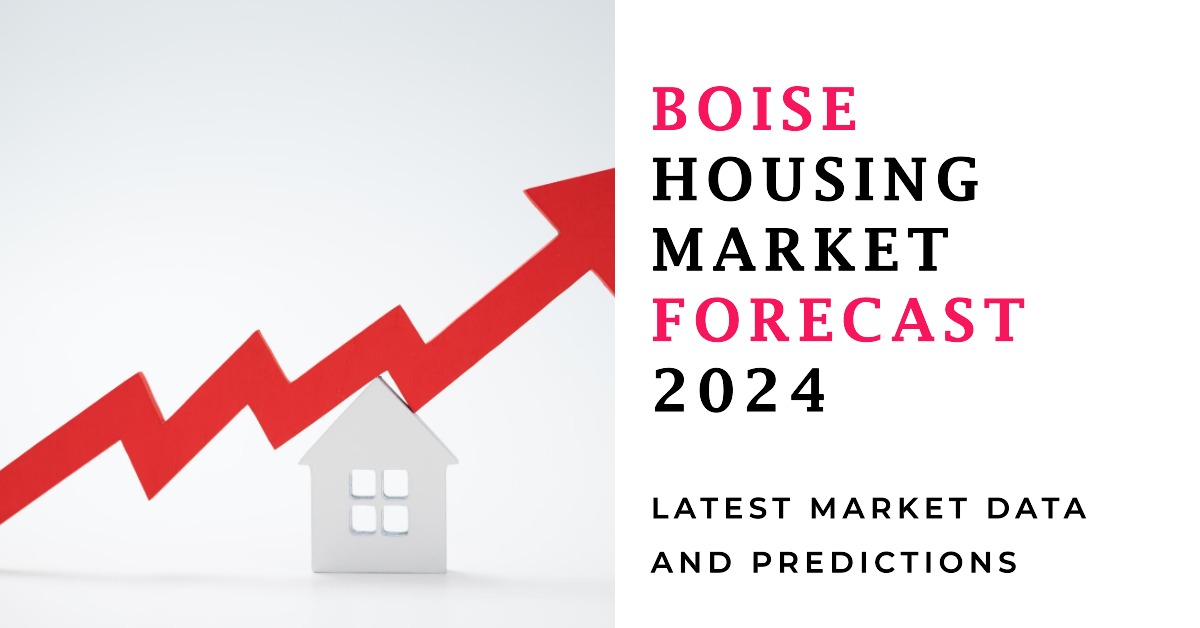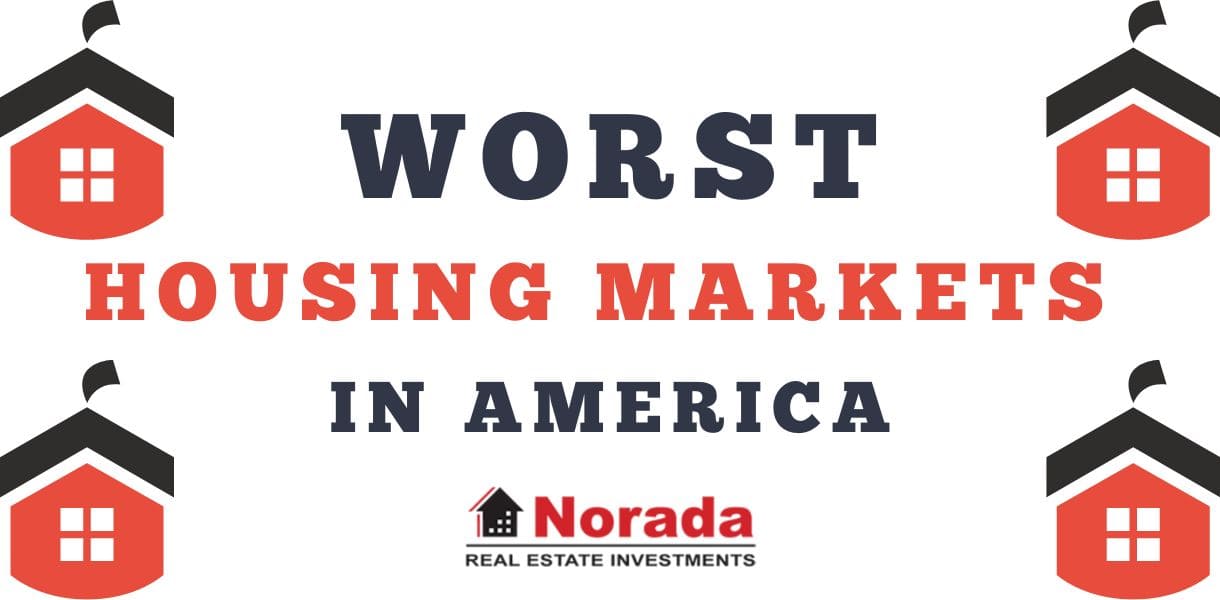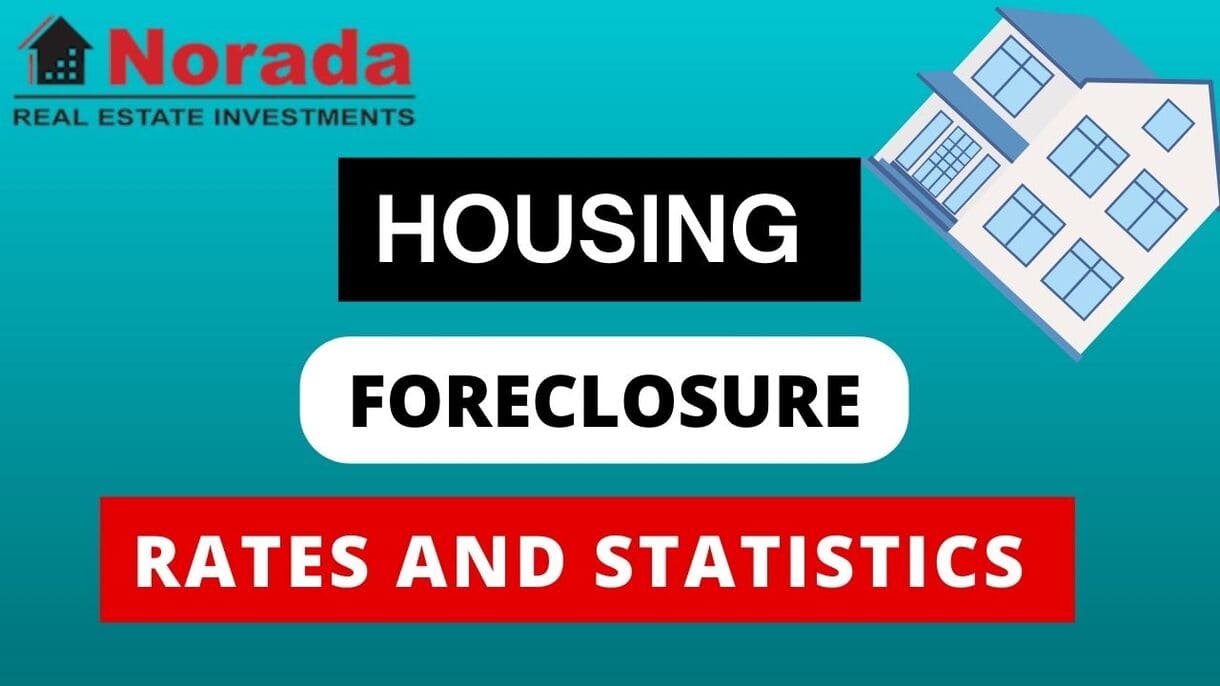The current state of the Boise housing market leans more towards being a seller's market, albeit with nuances that cater to both buyers and sellers. While low inventory levels and intense competition among buyers suggest a seller's market, factors such as cautious buyer behavior and pricing strategies contribute to a balanced dynamic. Overall, sellers are enjoying favorable conditions, but buyers who are strategic and discerning can still find opportunities in this market.
How is the Boise housing market doing currently?
Market Trends and Statistics
In February, we witnessed a mixed bag of statistics reflecting the pulse of the housing market. According to the report by Weknowboise.com, Ada County saw a notable acceleration in home price gains, with the median price soaring by 6.3% to $522,000, marking the most significant yearly increase since August 2022. Conversely, neighboring Canyon County experienced a 5.1% increase, with median prices reaching $409,818.
Boise Real Estate Market Stats
- Median list price: $475,000, down $18,375 (-3.8%)
- Median sold price: $478,200, up $5,795 (-1.2%)
- Average price per square foot: $309 (10.4%)
- Total home sales: 192 (down 30)
- Median days on market: 16 days (down 29)
- Available homes for sale: 1.17 month supply (up 0.04)
- 30-year mortgage rate: 6.78% (up 0.52)
However, the story doesn't end there. Boise itself witnessed a slight decline in median home prices by 1.2%, with prices now resting at $478,200. Yet, this dip is largely attributed to the mix of homes sold, as on a per-square-foot basis, prices surged by an impressive 10.4%.
Meridian, a standout in the region, recorded remarkable gains with home prices skyrocketing by 15.8% compared to the previous February, reaching an impressive $549,000.
Despite the price fluctuations, the overall demand for homes remains robust. However, challenges such as low inventory and adverse weather conditions, such as January's unusually snowy weather, have contributed to a slight dip in sales volume.
Factors Influencing the Market
The current market scenario is influenced by various factors, one of the primary ones being mortgage rates. While rates are slightly higher than at the beginning of the year, they remain lower than the multidecade highs seen last fall, hovering around 6.88% for 30-year loans.
Furthermore, the housing market is witnessing a tug-of-war between buyers and sellers. Many homeowners, enjoying historically low interest rates, are hesitant to sell, contributing to a constrained supply of existing homes. This limited inventory, particularly in the move-in-ready segment priced under $500,000, has led to intense competition among buyers, often resulting in bidding wars.
Moreover, buyers are becoming increasingly discerning, prioritizing quality and location. Updated, turnkey homes close to amenities are in high demand, while properties requiring significant renovations are facing lukewarm interest.
Future Outlook
Looking ahead, the housing market's trajectory hinges heavily on supply dynamics. Inventory levels remain below normal, with Ada County sporting a mere 1.78-month supply and Canyon County slightly better at 2.03 months—far from the 4–6 months indicating a balanced market.
Nevertheless, despite the supply constraints, there's no shortage of buyers in the market. However, pricing strategy plays a pivotal role, with correctly priced homes garnering significant interest while overpriced ones struggle to find buyers.
Are Home Prices Dropping in Boise?
While there have been fluctuations in median home prices in certain areas like Boise itself, the overall trend in the Treasure Valley region shows steady growth. Despite the slight dip in median home prices in Boise, factors such as the mix of homes sold and per-square-foot price increases indicate underlying strength in the market. Therefore, while individual areas may experience temporary declines, the broader trend suggests a trajectory of appreciation rather than depreciation.
Ada County Housing Market Trends
According to the Boise Regional REALTORS®, the Ada County housing market continues to demonstrate resilience and adaptability, reflecting the dynamic nature of real estate in the region.
Median Sales Price
In February 2024, the median sales price for single-family homes in Ada County experienced a significant surge compared to both the previous month and the same period last year. Buyers witnessed an increase of nearly $10,000 from January 2024, while the spike soared to almost $30,000 when juxtaposed with February 2023 figures. Notably, new construction also saw a remarkable uptick, jumping approximately $25,000 compared to both the previous month and February 2023.
Homes Sold
Despite the lingering effects of the previous year's market dynamics, sales in Ada County exhibited promising signs in February 2024. While still below 2023 levels, there was a notable uptick in month-over-month sales, with double-digit increases observed since January 2024. Out of the 527 sales recorded, 44 transactions soared past the $1 million mark, underscoring the diverse nature of the housing market.
Pending Sales
February 2024 marked a significant milestone as pending sales surged past 1,000 signed contracts for the first time since May 2023. Particularly noteworthy was the resurgence in pending sales for new construction, reminiscent of the market fervor witnessed in August 2022.
Inventory
One of the most striking developments in Ada County's housing market is the surge in inventory. This increase, coupled with a rise in the median sales price, offers buyers a wider array of options while navigating the market dynamics. Although Ada County remains predominantly a seller's market, the expanded inventory presents opportunities for negotiation and exploration.
Days on Market
Contrary to expectations, higher-priced homes did not significantly languish on the market in Ada County. Despite 44 homes fetching over $1 million, the average days on market remained relatively stable at 51 days, only slightly longer than the overall average of 49 days. This trend suggests a healthy balance between supply and demand, bolstering seller confidence in the market.
A Perspective from BRR's President
Elizabeth Hume, Boise Regional REALTORS® 2024 President, emphasizes the significance of shorter days on the market in instilling confidence among sellers. The data paints a picture of a robust Spring market, offering promising opportunities for both buyers and sellers alike.
RECOMMENDED READING: Idaho Housing Market Forecast for 2024
Boise Housing Market Forecast for 2024 and 2025
According to Zillow, the Boise housing market continues to show resilience and promise. The average home value in Boise stands at $473,115, reflecting a 1.8% increase over the past year. Notably, homes in Boise typically go pending in approximately 22 days, indicating a healthy demand-supply balance.
Key Housing Metrics Explained
- For Sale Inventory: As of February 29, 2024, Boise had 487 properties listed for sale, providing buyers with a range of options.
- New Listings: In February 2024, Boise witnessed 165 new listings, suggesting ongoing activity in the housing market.
- Median Sale to List Ratio: The median sale to list ratio as of January 31, 2024, stood at 0.990, indicating that properties were typically selling close to their listed prices.
- Median Sale Price: The median sale price for homes in Boise was $468,300 as of January 31, 2024.
- Median List Price: The median list price for homes in Boise was $550,450 as of February 29, 2024, indicating the price range buyers can expect.
- Percent of Sales Over/Under List Price: In January 2024, 16.1% of sales were over list price, while 58.2% were under list price, reflecting the negotiation dynamics in the market.
Boise City MSA Housing Market Forecast
Boise City MSA, which stands for Metropolitan Statistical Area, encompasses Boise and its surrounding areas. It is a designated region used by governmental agencies and organizations for statistical purposes, providing insights into broader economic and demographic trends. The Boise City MSA includes Ada County, Canyon County, and Gem County. With a population exceeding 750,000, this MSA boasts a robust housing market driven by factors such as job growth, affordability, and quality of life.
The housing market forecast for Boise City MSA indicates promising growth in the coming months. Based on data projections, from February 29, 2024, to March 31, 2024, there is an estimated 0.5% increase in housing market performance. Looking further ahead, from March 31, 2024, to May 31, 2024, the forecast predicts a more substantial 2.1% uptick. By February 28, 2025, the market is anticipated to experience a noteworthy 4.2% growth, signifying sustained momentum and investor confidence in the region's real estate landscape.
Will the Boise Housing Market Crash?
There is currently no evidence to suggest an imminent housing market crash in Boise. The market has demonstrated resilience and stability, with controlled price appreciation and reasonable inventory levels. However, it's crucial to acknowledge that real estate markets are influenced by various factors, including economic conditions, interest rates, and external events. Continuous monitoring and prudent decision-making are essential to navigate potential risks.
Is Now a Good Time to Buy a House in Boise?
For prospective homebuyers, the decision to purchase a house in Boise depends on individual circumstances and long-term goals. With favorable interest rates as compared to last year and a diverse housing inventory, now could be an opportune time to enter the market, especially for those seeking stability and potential appreciation. However, it's essential to conduct thorough research, assess personal finances, and consult with real estate professionals to make an informed decision aligned with one's objectives.

Is Now a Good Time to Buy a House in Boise Idaho?
Considering the current Boise housing market dynamics, characterized by a balanced scenario favoring both buyers and sellers, the decision to buy a house in Boise, Idaho, appears promising. With an average home value of $473,115, showing a slight 1.8% increase over the past year, and homes going pending in approximately 22 days, the market reflects responsiveness and opportunity.
While the market has experienced a modest adjustment, it is not indicative of an imminent crash. The 16.1% of sales over list price and 58.2% under list price suggest a dynamic environment.
Considering these factors, now could be seen as a reasonable time for potential homebuyers. However, it is essential for individuals to engage with local real estate professionals, stay informed about market trends, and assess their unique circumstances before making a decision.
Interest Rates
Consider the current interest rates for mortgages. Lower interest rates can make buying a home more affordable over the long term. If interest rates are favorable, it might be a good time to consider buying, as it could result in lower monthly mortgage payments.
Personal Financial Situation
Assess your own financial stability and readiness for homeownership. Evaluate your income, savings, credit score, and other financial commitments. Buying a home is a significant financial decision, and it's important to ensure that you're financially prepared for both the upfront costs and ongoing expenses of homeownership.
Affordability
Look at the affordability of homes in your desired area of Boise. Calculate your budget, taking into account not only the purchase price but also property taxes, homeowners insurance, maintenance costs, and potential homeowners association (HOA) fees.
Long-Term Goals
Consider your long-term goals and how buying a home aligns with them. Do you plan to stay in Boise for an extended period? Does homeownership fit into your lifestyle and future plans? Real estate is generally a long-term investment, so it's important to have a clear vision of how homeownership fits into your overall life plan.
Local Economy and Job Market
Research the local economy and job market in Boise. A stable and growing job market can positively impact housing demand and property values. If the job market is strong and diverse, it might indicate a stable real estate market.
Supply and Demand
Evaluate the supply and demand dynamics in the Boise housing market. If there is high demand and limited housing inventory, it could lead to competitive bidding and potentially higher prices. Conversely, a higher inventory might offer more options and negotiating power for buyers.
Is Boise Idaho a Good Place to Invest in Real Estate?
1. Population Growth and Trends
The first crucial factor to consider when contemplating real estate investment is the population growth and trends in Boise. As of the latest data, Boise has experienced a significant surge in population, with a growth rate well above the national average. This influx of residents is indicative of a thriving city, making it an attractive prospect for real estate investment.
2. Economy and Jobs
Boise's robust economy and job market play a pivotal role in determining the city's real estate potential. The region has seen consistent economic growth, driven by diverse industries. The presence of stable employment opportunities is a positive sign for real estate investors, as a strong job market contributes to increased housing demand.
3. Livability and Other Factors
Investors should also assess the livability of the city, considering factors such as education, healthcare, and recreational amenities. Boise consistently ranks high in livability indices, boasting quality schools, healthcare facilities, and a plethora of outdoor activities. A city with a high livability score tends to attract long-term residents, ensuring sustained demand for housing.
4. Rental Property Market Size and Growth
For real estate investors, the size and growth of the rental property market are critical considerations. Boise's rental market has expanded in tandem with its population growth, providing ample opportunities for investors. The demand for rental properties is on the rise, creating a favorable environment for those looking to capitalize on rental income.
Boise's rental market has witnessed a substantial increase in size in direct correlation with the city's population growth. As more individuals migrate to Boise, the demand for housing, particularly in the rental sector, has surged. This expansion in the market size not only signifies a robust housing demand but also presents a wealth of opportunities for investors to tap into a growing pool of tenants.
The growth trajectory of Boise's rental property market is a testament to the city's economic vitality and attractiveness. The consistent influx of residents, coupled with a thriving job market, has contributed to a sustained demand for rental properties. Investors looking for markets with a positive growth outlook will find Boise's rental sector aligning seamlessly with their objectives.
One of the key drivers of this growth is the booming local economy. Boise has become a hub for various industries, attracting professionals and individuals seeking employment opportunities. As these individuals relocate to the city, the need for rental accommodations intensifies, creating a dynamic and competitive rental property market.
Moreover, the rising demand for rental properties in Boise is not solely driven by population growth. The city's appeal as a desirable place to live, work, and raise a family contributes to a steady influx of residents. The quality of life, outdoor recreational options, and community amenities make Boise an attractive destination, enhancing the demand for rental housing options.
For investors, this scenario creates a favorable environment to capitalize on rental income. With a growing market and increasing demand, rental properties in Boise present a lucrative opportunity for both short-term and long-term returns on investment. The potential for rental appreciation and a consistent stream of tenants make Boise a strategic choice for those looking to build a robust and diversified real estate portfolio.
5. Other Factors Related to Real Estate Investing
Several additional factors contribute to Boise's allure for real estate investors. These include favorable real estate policies, a well-established real estate infrastructure, and a proactive local government supporting sustainable development. Investors should also keep an eye on market trends and forecasts to make informed decisions.
REFERENCES:
- https://www.boirealtors.com
- https://www.weknowboise.com
- https://www.zillow.com/boise-id/home-values




